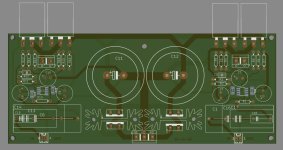I added Gerber.zip to my first post #1
So now all needed files are at the start of this topic.
Enjoy 🙂
So now all needed files are at the start of this topic.
Enjoy 🙂
I'm not sure where everybody here is geographicaly but there is these guys, that seem to be cheap.
https://www.pcbway.com/orderonline.aspx
https://www.pcbway.com/orderonline.aspx
JLCPCB.com has better pricing. Very fast service and never had a problem with the board quality.I'm not sure where everybody here is geographicaly but there is these guys, that seem to be cheap.
https://www.pcbway.com/orderonline.aspx
Most modern opamps are only available in SMD packages.
Stefan,
Thank you for coloring in this small amp idea. Wonderful.
My mind goes to a BTL version. It would probably fit on a similar sized PCB, and could bring an approximate power of 40W to the music...perhaps even more power output if the rails are stretched to a brave16 volts...!
David
Thank you for coloring in this small amp idea. Wonderful.
My mind goes to a BTL version. It would probably fit on a similar sized PCB, and could bring an approximate power of 40W to the music...perhaps even more power output if the rails are stretched to a brave16 volts...!
David
OPA1655 has only SMD version.There are two OpAmps and four capacitors in SMD form.
I assume that is not too much and reasonable here.
Small caps SMD around op-amp -see datasheet.
There are not many PDIP opamps around no more.
OPA134 and OPA2134 are PDIP. So is OPA604 and OPA2604.
Maybe possible to use one of them. But they are not Rail to Rail outputs ...
I would have to simulate and see what they can do.
-----
Yes, OPA134 will work as well.
Max output is 10,17 Watt.
Which is same as OPA1655.
But OPA604 will not work.
OPA134 and OPA2134 are PDIP. So is OPA604 and OPA2604.
Maybe possible to use one of them. But they are not Rail to Rail outputs ...
I would have to simulate and see what they can do.
-----
Yes, OPA134 will work as well.
Max output is 10,17 Watt.
Which is same as OPA1655.
But OPA604 will not work.
Last edited:
That is my opinion, too.There are two OpAmps and four capacitors in SMD form.
I assume that is not too much and reasonable here.
Now that we have a good PCB, I wait for people to build this amplifier.
It suits well for those who have speakers with higher sensitivity.
So is 10 Watt enough.
Even when I listen to music quite loudly, the envelope curve of the signal documented over a longer period of time, tapped directly at the loudspeaker, only shows me a maximum calculated output of 2W -> U^2 / 8 [V/A].
10 times 2 is 20, that's how I get to my mark.
greetings,
HBt.
10 times 2 is 20, that's how I get to my mark.
greetings,
HBt.
The present design is a fantastic, fast entry-level project
#
Even a peak level detector basically documents the same thing -> we usually stay below 10W_peak.
The small Indian in question will probably be able to deliver 18 peak watts, always in relation to a sine, relatively undistorted.
So there is no problem.
Bye

Psst
If this were not the case, then the NAD3020 & MF-A1 ..., for example, would not be suitable for hi-fi, they would be far too weak-chested.
#
Even a peak level detector basically documents the same thing -> we usually stay below 10W_peak.
The small Indian in question will probably be able to deliver 18 peak watts, always in relation to a sine, relatively undistorted.
So there is no problem.
Bye

Psst
If this were not the case, then the NAD3020 & MF-A1 ..., for example, would not be suitable for hi-fi, they would be far too weak-chested.
Last edited:
Honestly, probably more cost effective and less headache to order a minimum batch of 5 pcb’s from JLCPCB and use the snail mail option to your door.
@ZoltanChivay
Only thing I don't like in the PCB file,
is the caps that decouple the opamps.
They are SMD types. I would have liked through hole caps 100nF.
Only thing I don't like in the PCB file,
is the caps that decouple the opamps.
They are SMD types. I would have liked through hole caps 100nF.
- Home
- Amplifiers
- Solid State
- Choctaw - 10 Watt Amplifier, 1 Opamp + 2 MOSFET
